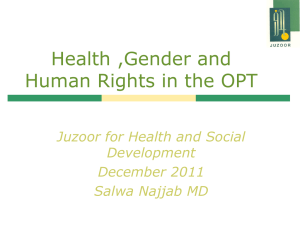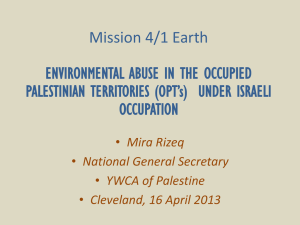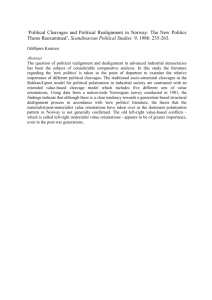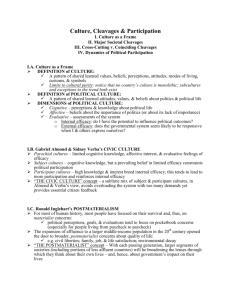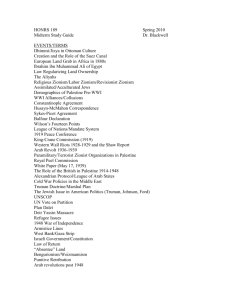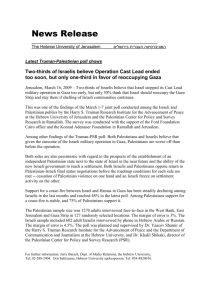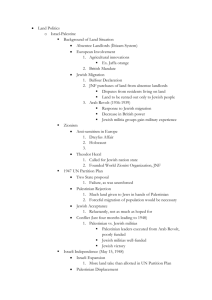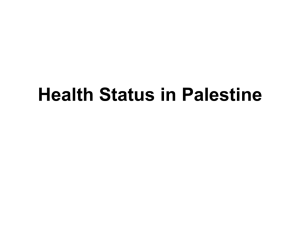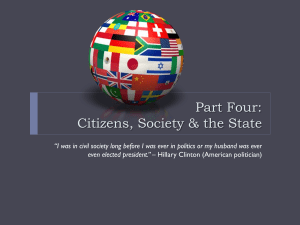Societal Cleavages & Cultural Conflict
advertisement
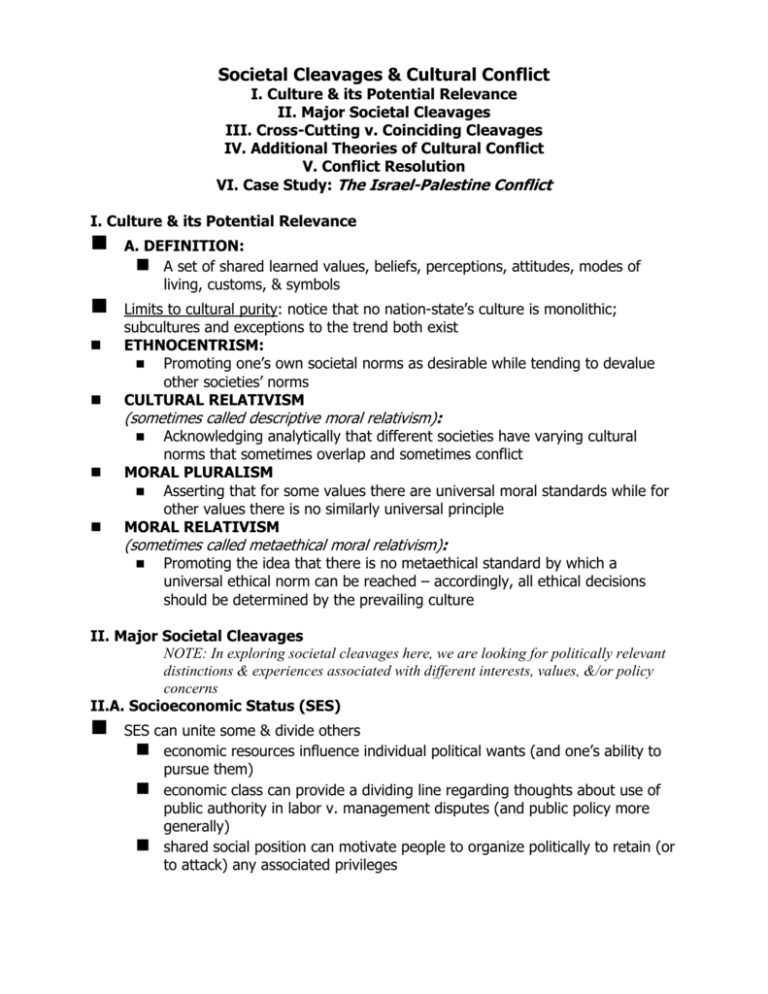
Societal Cleavages & Cultural Conflict I. Culture & its Potential Relevance II. Major Societal Cleavages III. Cross-Cutting v. Coinciding Cleavages IV. Additional Theories of Cultural Conflict V. Conflict Resolution VI. Case Study: The Israel-Palestine Conflict I. Culture & its Potential Relevance A. DEFINITION: A set of shared learned values, beliefs, perceptions, attitudes, modes of living, customs, & symbols Limits to cultural purity: notice that no nation-state’s culture is monolithic; subcultures and exceptions to the trend both exist ETHNOCENTRISM: Promoting one’s own societal norms as desirable while tending to devalue other societies’ norms CULTURAL RELATIVISM (sometimes called descriptive moral relativism): Acknowledging analytically that different societies have varying cultural norms that sometimes overlap and sometimes conflict MORAL PLURALISM Asserting that for some values there are universal moral standards while for other values there is no similarly universal principle MORAL RELATIVISM (sometimes called metaethical moral relativism): Promoting the idea that there is no metaethical standard by which a universal ethical norm can be reached – accordingly, all ethical decisions should be determined by the prevailing culture II. Major Societal Cleavages NOTE: In exploring societal cleavages here, we are looking for politically relevant distinctions & experiences associated with different interests, values, &/or policy concerns II.A. Socioeconomic Status (SES) SES can unite some & divide others economic resources influence individual political wants (and one’s ability to pursue them) economic class can provide a dividing line regarding thoughts about use of public authority in labor v. management disputes (and public policy more generally) shared social position can motivate people to organize politically to retain (or to attack) any associated privileges II.B. Region A common subnational region can unite residents to mobilize to protect regional traditions to extract additional financial resources from the national government to gain greater political autonomy from the central government EXAMPLES? Northern League (Italy) Dixiecrats (U.S.) Scottish National Party (UK) various provincial parties in Brazil (and elsewhere in Latin America) th Alliance for Democracy (Nigerian 4 Republic) II.C. Ethnicity A. Members of ethnic groups can develop a shared identity based on: common (presumed) racial ancestry common place of residence common language common customs & practices B. As we will discuss shortly, ethnicity becomes more powerful when members of certain ethnic groups are additionally united by a common position on some or many other cleavages: socioeconomic status, region, religion, ideology, etc. II.D. Religion Religion is a potentially all-encompassing belief system divine authority superior to all others in all realms by extension, deviation from those norms is heretical: should not be tolerated → violates moral code cannot be tolerated → toleration implies heresy Models of Church-State Relations Separation of Church & State formal policies that aim at no entrenchment of religion e.g. U.S. (albeit amid underlying Judeo-Christian tradition) Hybrid model freedom of religion & freedom of political authority from religious authority are combined with some/many policies that entrench &/or favor particular religions most countries in the world fit this profile Theocracy leaders of organized religion have an institutionalized (& crucial) role in government e.g. the Islamic Republic of Iran established in 1979 II.E. Political Ideology Classical Liberalism PHILOSOPHICAL ANTHROPOLOGY people are rational & have free will people are naturally self-interested BASIC TENETS political freedom → expansion of political participation economic freedom → expansion of market’s role emphasis on equality of opportunity rather than of outcomes Classical Marxism PHILOSOPHICAL ANTHROPOLOGY people are rational people’s self-interest is situational: class relations define people’s true interests BASIC TENETS political & economic equality are the source of true freedom emphasis on equality of outcome as basis of equality of opportunity III. Cross-Cutting v. Coinciding Cleavages cross-cutting cleavages cleavages that generally do not travel together coinciding (reinforcing) cleavages several/many cleavages travel together: people from a certain region or ethnic group share similar SES, language, religion, and/or ideology When several cleavages coincide, sociopolitical tension and conflict tend to be greater than when cleavages tend to be cross-cutting… hypothetical examples of cleavage patterns Largely cross-cutting Fully coinciding Ethnic A Ethnic B Ethnic A Ethnic B NORTH 30% 70% 100% 0% south 70% 30% 0% 100% URBAN 75% 65% 100% 0% rural 25% 35% 0% 100% PROTESTANT 40% 50% 100% 0% Catholic 60% 50% 0% 100% AFFLUENT 60% 45% 100% 0% poor 40% 55% 0% 100% IV. Additional Theories of Cultural Conflict A. Samuel Huntington’s “Clash of Civilizations” thesis (1996) Huntington argued that political ideologies were the central cleavage of the 20th century (liberalism, fascism, & marxism) but that the end of the Cold War would make religiously demarcated cultures/civilizations the major cleavage of the 21st century Huntington divides the world into 8 major civilizations – Western (Protestant?), Confucian, Japanese, Islamic, Hindu, Slavic-Orthodox, Latin American (Catholic?), & African Some subsequent analysts have tried to simplify Huntington’s analysis into a clash between Judeo-Christian & Islamic civilizations Many other analysts have pointed out the gaps in these religiously-framed visions of cultural conflict Cultures are complex and do not consistently guide international relations Religion, in particular, is not a consistent driver of international conflicts Where and when religion has been a major driver of conflicts, typically there have been coinciding cleavages IV. Additional Theories of Conflict B. Thinking through causal drivers that can activate or exacerbate conflicts V. Conflict Resolution Peacemaking promoting the cessation of violent hostilities [Note the contrast here with Payne’s discussion.] Part of the UN Charter (Chapter VI) Peacekeeping promoting the enforcement of ceasefires and peace agreements via the invited presence of troops 67 UN peacekeeping missions launched from 1948-2012 involving troops from 120 countries In mid-2012 there were 17 open missions involving 119,000 people Peacebuilding promoting a lasting conflict resolution via the promotion of socioeconomic and political reform and consensus-building In 2005 the UN created the Peacebuilding Commission to manage and promote these operations VI. Case Study: The Israel-Palestine Conflict A. A capsule history of Palestine For centuries, a multiethnic territory within the Ottoman Empire Jerusalem is a holy city for the three largest monotheistic religions – Judaism, Christianity, & Islam th The Zionist movement forms in the late 19 century to pursue the creation of a Jewish state in Palestine The United Kingdom gains a League of Nations mandate to govern Palestine (and much of the Middle East, along with France) after World War I The 1917 Balfour Declaration declares support for the creation of a Jewish state in Palestine (but did not call for a Jewish Palestine) Zionists fund Jewish immigration to Palestine (from 7 to 30% of pop.) Arab Palestinian unhappiness leads to the UK to discourage Jewish immigration in 1921 Jewish asymmetrical warfare (by the Irgun) reopens immigration A 1937 British commission calls for a two-state solution World War II exhausts British financial resources while renewed Indian pressure leads to widespread calls for decolonization in the British Empire (and around the world more generally) In Nov. 1947, the UN votes 33 to 13 (with 10 abstentions) for a two-state solution & for international control of Jerusalem & Bethlehem In May 1948, Israel unilaterally declares its independence prior to UN implementation (but right after British withdrawal) Neighboring Arab states invade immediately & then lose the First Arab-Israeli War Many Arab Palestinians flee during the conflict (esp. after the tragedy at Deir Yassin) For Arab Palestinians, these events become known as the nakba (catastrophe) They demand a right of return to their lost land that was embraced by UN Resolution 194 In the fighting, Israel expands its borders beyond the UN partition lines Egypt seizes the Gaza Strip & Jordan controls the West Bank When Egypt mobilized on the border & talked of invasion, an effective Israeli air strike and land invasion wins the 1967 6-Day War Israel dramatically expands its borders re: Egypt (Gaza & the Sinai Peninsula), Jordan (the West Bank), and Syria (the Golan Heights) This displaces over 500,000 Palestinians from a now Israeli-controlled Palestine Palestinians lose faith in an Arab League-led solution & then gain control over the Palestinian Liberation Organization (PLO) by 1969 under the leadership of Yasser Arafat The PLO at times engages in terrorism & guerrilla warfare to draw attention to its cause Egypt would eventually recognize Israel in a 1979 Peace Accord & regain the Sinai In 1987-1993 the first Palestinian intifada (uprising) challenges Israeli occupation of the West Bank & Gaza In 1988 the PLO says that it will renounce violence if a two-state solution can be pursued via implementation of existing UN Resolutions: UN General Assembly Resolution 181 (the 1947 partition plan) UN Security Council Resolution 242 (the 1967 call for Israeli withdrawal from lands gained the Six-Day War in exchange for the mutual recognition of all states & an end to hostilities) The 1991 Madrid Conference marks the first major public talks between Israeli & Palestinian leaders The 1993 Oslo Accords Created an interim (limited) self-government, the Palestinian Authority (PA), in the West Bank and the Gaza Strip Mandated that the Palestinian Authority would hold free elections Mandated that the Israeli gov’t would withdraw from Gaza and, within five years, from the West Bank Established 3 zones of authority in the West Bank Zone A controlled by the PA Zone B jointly controlled Zone C controlled by Israel (and filled with Jewish settlements) The 2000 Camp David Accords fail in July The second intifada begins in September 2000 & runs through 2006 Israeli troops pull out of Gaza in 2005, then launch a seige once Hamas wins the 2006 elections VI. Case Study: The Israel-Palestine Conflict B. Some food for thought What have Palestinians historically demanded that the Israeli government has been willing to accept? What have Israelis historically demanded that the Palestinian leaders have been willing to accept? If you could pick one concession that the Israeli government could make to move toward a more lasting peace, what would it be? In turn, why and how do think it will help to resolve the conflict? If you could pick one concession that the Palestinian leadership could make to move toward a more lasting peace, what would it be? In turn, why and how do think it will help to resolve the conflict? Demographic data on Israel & Palestine Gaza Strip Israel West Bank 1.56m 7.23m 2.46m % Jewish 0% 75% 17% % Muslim 99% 17% 75% % urban 72% 92% 72% 16.0/1000 4.2/1000 18.4/1000 $28,400 $2,900 [avg. w/ Gaza] 40% 8% 19% 70% < $1. 08/day 23% < $7.30/day 46% < $1.08/day population infant mortality GDP/capita [PPP] $2,900 [avg. w/ West Bank] unemployment poverty rate

